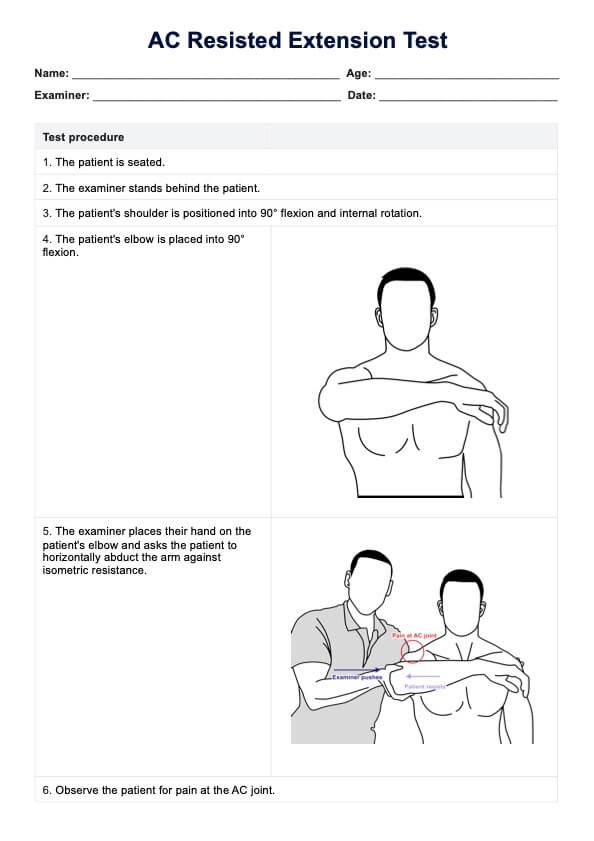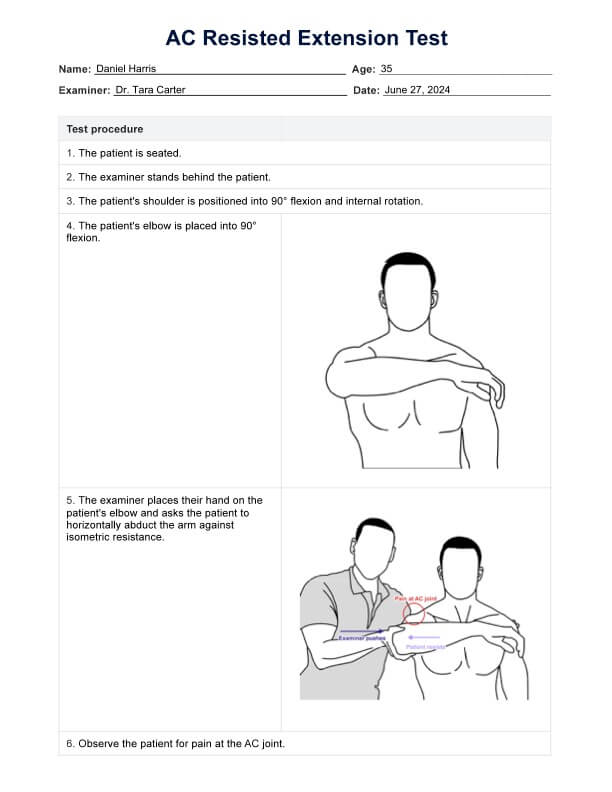AC Resisted Extension Test
Learn about the AC Resisted Extension Test, a reliable method to assess acromioclavicular joint pathology. Access our free template for accurate diagnosis.


What is acromioclavicular joint pathology?
Acromioclavicular (AC) joint pathology refers to disorders affecting the acromioclavicular joint, which is located at the top of the shoulder where the acromion (a part of the scapula/shoulder blade) meets the clavicle. This joint plays a critical role in shoulder movement and stability, acting as a pivot point for shoulder motion and transmitting forces from the arm to the rest of the body.
The AC joint consists of various structures, including the joint capsule, ligaments (such as the acromioclavicular and coracoclavicular ligaments), cartilage, and the surrounding muscles. When any of these components are damaged or degenerated, it can lead to AC joint pathology. This condition is commonly seen in athletes involved in contact sports, individuals with repetitive overhead activities, and those who have sustained trauma to the shoulder.
Symptoms of acromioclavicular joint pathology
Symptoms often include acromioclavicular joint pain localized at the top of the shoulder, which can be exacerbated by activities such as lifting, reaching across the body, or performing overhead movements. Patients may also experience swelling, tenderness, and a visible bump over the joint. In chronic cases, there may be a decreased range of motion and a feeling of instability in the shoulder.
Causes of this pathology
AC joint pathology can result from various causes, including acute injuries like falls directly onto the shoulder, chronic overuse from repetitive activities, and degenerative changes associated with aging. Specific conditions that can lead to AC joint pathology include AC joint arthritis, osteolysis of the distal clavicle, and AC joint separations, where the ligaments supporting the joint are damaged.
Potential complications this pathology may lead to
If left untreated, AC joint pathology can lead to significant complications, such as chronic AC joint pain, persistent shoulder dysfunction, and reduced ability to perform daily activities or participate in sports. In severe cases, it can cause long-term disability and require surgical intervention to restore function and alleviate symptoms.
AC Resisted Extension Test Template
AC Resisted Extension Test Example
What is the AC Resisted Extension Test?
The AC Resisted Extension Test is a clinical assessment tool designed to identify pathologies such as AC joint separation, instability, osteoarthritis, and other AC joint disorders. This test specifically targets conditions affecting the AC joint, which is the junction between the acromion (part of the scapula) and the clavicle. It is particularly useful for distinguishing AC joint issues from other shoulder conditions, such as impingement syndromes.
The purpose of the AC Resisted Extension Test is to provoke symptoms associated with AC joint pathology by applying isometric resistance to the shoulder in a specific position. The test helps diagnose conditions such as AC joint arthritis, AC joint separations, and chronic overuse injuries, which are common in athletes and individuals who perform repetitive overhead activities.
The reliability of the AC Resisted Extension Test is supported by research indicating a sensitivity of 72% and a specificity of 85%. It also has a positive likelihood ratio of 4.8 and a negative likelihood ratio of 0.33. This means the test has relatively high diagnostic accuracy in identifying true positives and true negatives for AC joint pathology. However, it is recommended to use this test in conjunction with other diagnostic tools and special tests, such as the Cross Body Adduction Test and O'Brien's Active Compression Test, for a more comprehensive assessment.
How is this test conducted?
Here are the steps:
- The patient is seated.
- The examiner stands behind the patient.
- The patient's shoulder is positioned into 90° flexion and internal rotation.
- The patient's elbow is placed into 90° flexion.
- The examiner places their hand on the patient's elbow and asks the patient to horizontally abduct the arm against isometric resistance.
- The examiner observes for shoulder pain at the AC joint location
How are the results interpreted?
A negative test, where no pain is observed, indicates that the AC joint is likely not the source of the shoulder pain. A positive is indicated by the presence of pain at the AC joint when the patient resists horizontal abduction. This suggests AC joint pathology.
Next steps after conducting this test
Following a positive AC Resisted Extension Test, additional physical tests should be performed to confirm the diagnosis and assess the severity of the condition. These tests may include the Cross Body Adduction Test, O'Brien's Active Compression Test, and imaging studies like X-rays or MRI. Based on the comprehensive evaluation, an appropriate treatment plan can be developed.
How to use our AC Resisted Extension Test template
Our AC Resisted Extension Test template is designed to streamline the process of conducting and documenting the test, making it easier for healthcare professionals to ensure accuracy and consistency.
Step 1: Access this template
Download or access the AC Resisted Extension Test template through the Carepatron app or the link on this page. Ensure that you have the latest version of the app. You can also edit the template in the app to tailor it to your needs and workflow.
Step 2: Explain the template
Before beginning the test, explain the purpose and steps of the AC Resisted Extension Test to the patient. This helps them understand what to expect and ensures their cooperation during the test.
Step 3: Perform the procedure
Follow the steps as they are outlined in the template. Ensure that you follow these steps carefully for consistency.
Step 4: Document findings
Document the test findings, including whether the test was positive or negative, and any additional notes or observations.
Step 5: Review and plan next steps
Review the documented findings and discuss the next steps with the patient. If the test is positive, consider additional tests or refer the patient for further evaluation and treatment.
Treatments for acromioclavicular joint pathology
Treating AC joint pathology involves various approaches depending on the severity and nature of the condition. Here are some common treatment options:
- Rest and activity modification: Avoid activities that exacerbate symptoms to allow the shoulder joint to heal. This is often the first line of treatment.
- Physical therapy: Strengthening and stretching exercises can help improve shoulder mechanics and reduce pain. A physical therapist can tailor a program to the patient's specific needs.
- Medications: Nonsteroidal anti-inflammatory drugs (NSAIDs) can help reduce pain and inflammation associated with AC joint pathology. In some cases, corticosteroid injections may be recommended for more severe pain.
- Ice and heat therapy: Applying ice can reduce inflammation and pain in the acute phase, while heat can help relax and loosen tissues in the chronic phase.
- Surgical intervention: For severe cases that do not respond to conservative treatments, surgical options such as AC joint resection or reconstruction may be considered. Surgery aims to restore joint stability and function.
Effective management of AC joint pathology often requires a combination of these treatments to achieve the best outcomes for the patient.
Commonly asked questions
The resisted AC extension test assesses acromioclavicular joint pathology by evaluating pain during resisted horizontal abduction of the shoulder.
Resisted extension is a physical test where the patient exerts force against resistance while extending a limb or joint to assess for pain or dysfunction.
An AC joint sprain typically causes sharp pain on the top of the shoulder, especially when moving the arm or lifting objects.







































































































